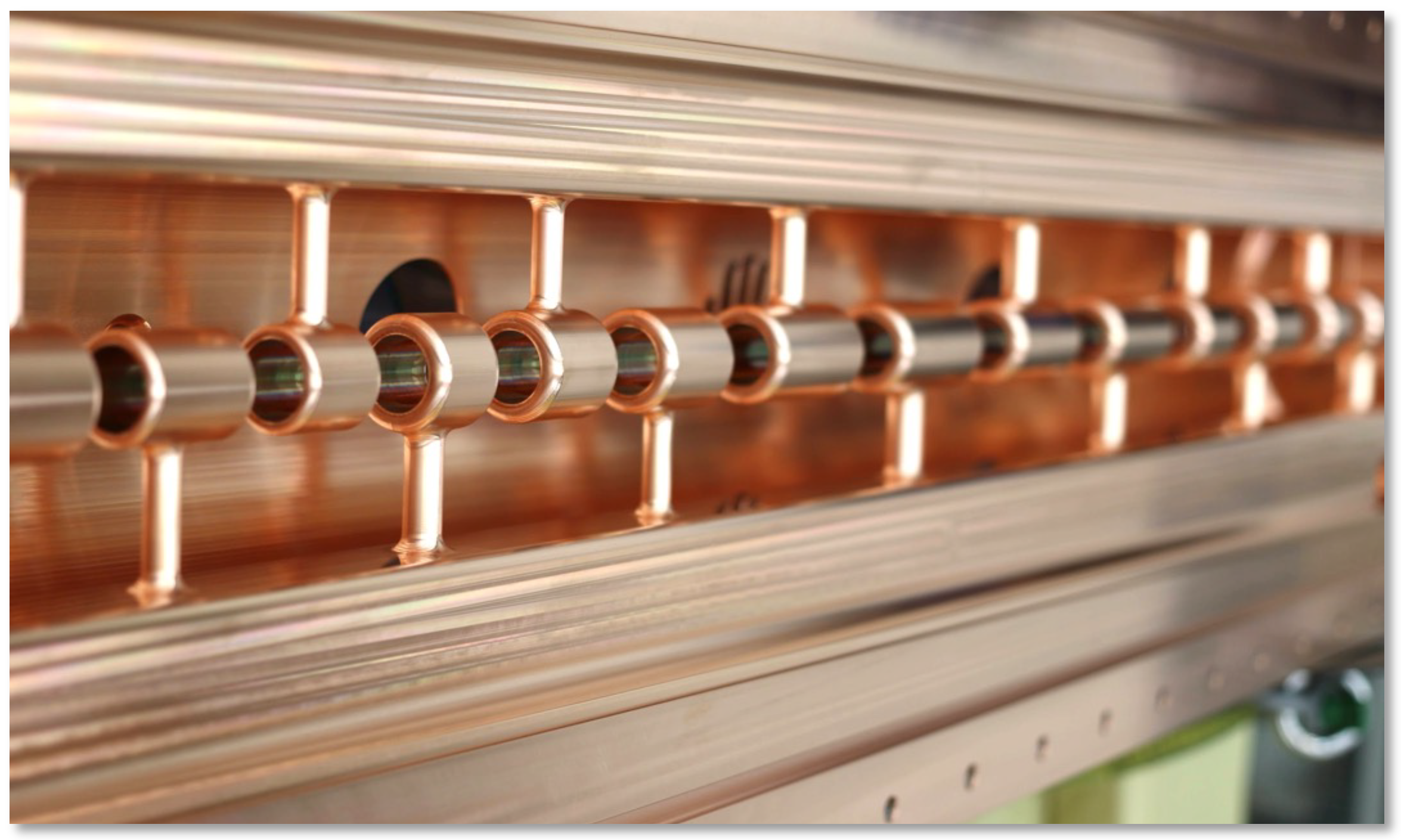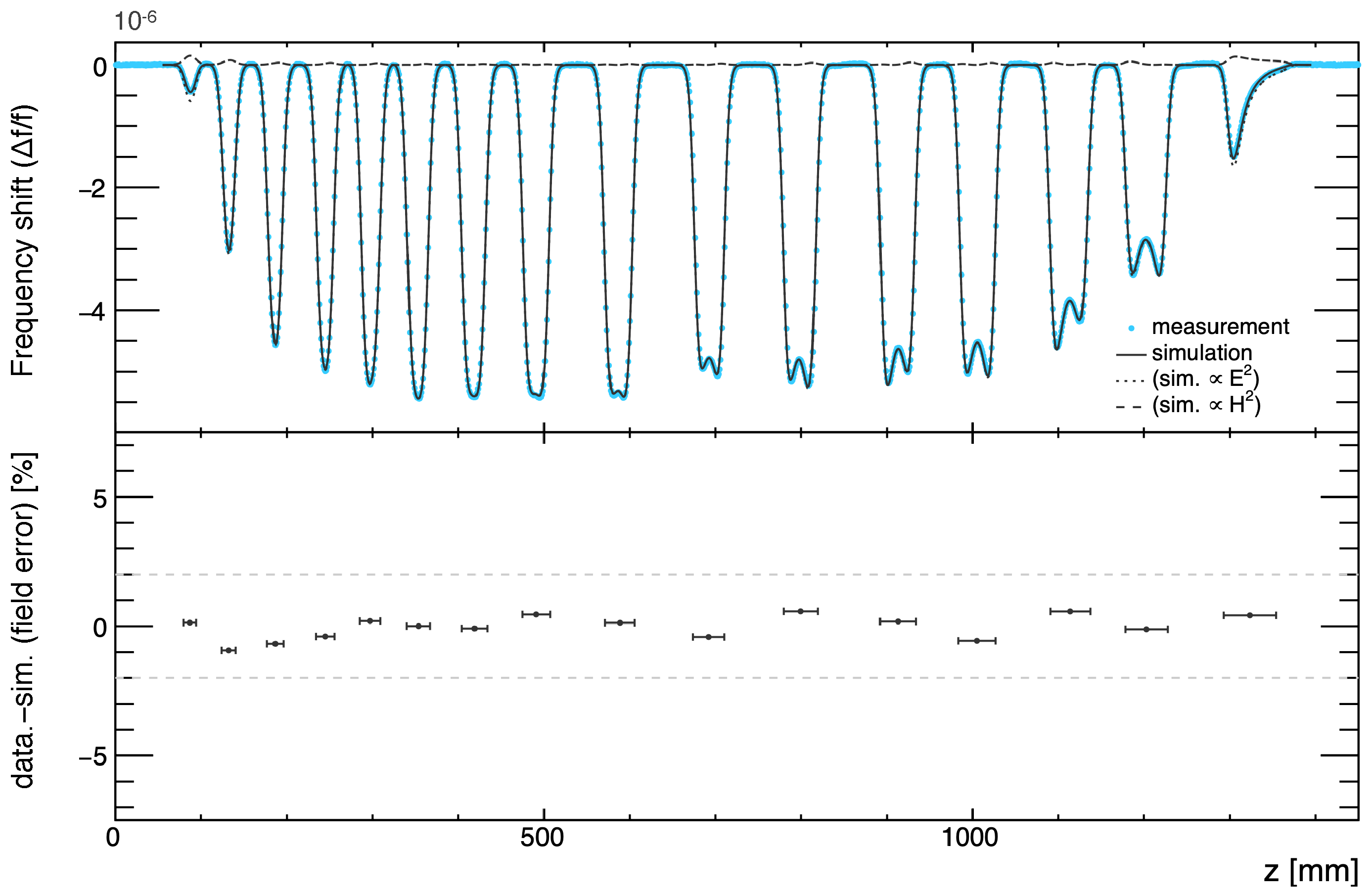Interdigital H-Mode Drift Tube Linear Accelerator for a Muon Linear Accelerator †
Abstract
:1. Introduction
2. Muon Linear Accelerator
3. Development of the IH-DTL
4. Summary and Prospects
Author Contributions
Funding
Institutional Review Board Statement
Informed Consent Statement
Data Availability Statement
Acknowledgments
Conflicts of Interest
References
- Bennett, G.W.; Bousquet, B.; Brown, H.N.; Bunce, G.; Carey, R.M.; Cushman, P.; Danby, G.T.; Debevec, P.T.; Deile, M.; Deng, H.; et al. Final report of the E821 muon anomalous magnetic moment measurement at BNL. Phys. Rev. D 2006, 73, 072003. [Google Scholar] [CrossRef] [Green Version]
- Abi, B.; Albahri, T.; Al-Kilani, S.; Allspach, D.; Alonzi, L.P.; Anastasi, A.; Anisenkov, A.; Azfar, F.; Badgley, K.; Baeßler, S.; et al. Measurement of the positive muon anomalous magnetic moment to 0.46 ppm. Phys. Rev. Lett. 2021, 126, 141801. [Google Scholar] [CrossRef] [PubMed]
- Aoyama, T.; Asmussen, N.; Benayoun, M.; Bijnens, J.; Blum, T.; Bruno, M.; Caprini, I.; Calame, C.C.; Cè, M.; Colangelo, G.; et al. The anomalous magnetic moment of the muon in the Standard Model. Phys. Rep. 2020, 887, 1–166. [Google Scholar] [CrossRef]
- Abe, M.; Bae, S.; Beer, G.; Bunce, G.; Choi, H.; Choi, S.; Chung, M.; Da Silva, W.; Eidelman, S.; Finger, M.; et al. A new approach for measuring the muon anomalous magnetic moment and electric dipole moment. Prog. Theor. Exp. Phys. 2019, 2019, 053C02. [Google Scholar] [CrossRef] [Green Version]
- Otani, M.; Kawamura, N.; Mibe, T.; Yamazaki, T.; Ishida, K.; Marshal, G. Simulation of Surface Muon Beamline, UltraSlow Muon Production and Extraction for the J-PARC g-2/EDM Experiment. J. Phys. Conf. Ser. 2018, 1067, 052018. [Google Scholar] [CrossRef]
- Kondo, Y.; Morishita, T.; Hasegawa, K.; Chishiro, E.; Hirano, K.; Hori, T.; Oguri, H.; Sato, F.; Shinozaki, S.; Sugimura, T.; et al. High-power test and thermal characteristics of a new radio-frequency quadrupole cavity for the Japan Proton Accelerator Research Complex linac. Phys. Rev. ST Accel. Beams 2013, 16, 040102. [Google Scholar] [CrossRef] [Green Version]
- Otani, M.; Mibe, T.; Yoshida, M.; Hasegawa, K.; Kondo, Y.; Hayashizaki, N.; Iwashita, Y.; Iwata, Y.; Kitamura, R.; Saito, N. Interdigital H-mode drift-tube linac design with alternative phase focusing for muon linac. Phys. Rev. Accel. Beams 2016, 19, 040101. [Google Scholar] [CrossRef] [Green Version]
- Takeuchi, Y.; Morishita, T.; Kitamura, R.; Nakazawa, Y.; Yamazaki, T.; Ego, H.; Cicek, E.; Kondo, Y.; Kawamura, N.; Iwashita, Y.; et al. Fabrication and Low-Power Test of Disk-and-Washer Cavity for Muon Acceleration. In Proceedings of the 13th International Particle Accelerator Conference (IPAC 2022), Bangkok, Thailand, 12–17 June 2022; pp. 1534–1537. [Google Scholar]
- Sumi, K.; Ego, H.; Iijima, T.; Inami, K.; Kondo, Y.; Mibe, T.; Moriya, K.; Nakazawa, Y.; Otani, M.; Saito, N.; et al. Design and Beam Dynamics Study of Disk-Loaded Structure for Muon Linac. In Proceedings of the 13th International Particle Accelerator Conference (IPAC 2022), Bangkok, Thailand, 12–17 June 2022; pp. 94–97. [Google Scholar]
- Otani, M. First muon acceleration and muon linear accelerator for measuring the muon anomalous magnetic moment and electric dipole moment. Prog. Theor. Exp. Phys. 2022, 2022, 052C01. [Google Scholar] [CrossRef]
- Bae, S.; Choi, H.; Choi, S.; Fukao, Y.; Futatsukawa, K.; Hasegawa, K.; Iijima, T.; Iinuma, H.; Ishida, K.; Kawamura, N.; et al. First muon acceleration using a radio-frequency accelerator. Phys. Rev. Accel. Beams 2018, 21, 050101. [Google Scholar] [CrossRef] [Green Version]
- Minaev, S.; Ratzinger, U.; Schlitt, B. APF or KONUS drift tube structures for medical synchrotron injectors—A comparison. In Proceedings of the 18th Particle Accelerator Conference, New York, NY, USA, 27 March–2 April 1999; pp. 3555–3557. [Google Scholar]
- Iwata, Y.; Yamada, S.; Murakami, T.; Fujimoto, T.; Fujisawa, T.; Ogawa, H.; Miyahara, N.; Yamamoto, K.; Hojo, S.; Sakamoto, Y.; et al. Alternating-phase-focused IH-DTL for an injector of heavy-ion medical accelerators. Nucl. Intrum. Methods Phys. Res. Sect. A 2006, 569, 685–696. [Google Scholar] [CrossRef]
- Iwata, Y.; Yamada, S.; Murakami, T.; Fujimoto, T.; Fujisawa, T.; Ogawa, H.; Miyahara, N.; Yamamoto, K.; Hojo, S.; Sakamoto, Y.; et al. Performance of a compact injector for heavy-ion medical accelerators. Nucl. Intrum. Methods Phys. Res. Sect. A 2007, 572, 1007–1021. [Google Scholar] [CrossRef]
- Ma, P.F.; Tang, R.; Yang, Y.; Zheng, S.X.; Ye, W.B.; Wang, M.W.; Liu, W.L.; Wang, B.C.; Xing, Q.Z.; Du, C.T.; et al. Development of a compact 325 MHz proton interdigital H-mode drift tube linac with high shunt impedance. Phys. Rev. Accel. Beams 2021, 24, 020101. [Google Scholar] [CrossRef]
- Computer Simulation Technology. CST Studio Suite. Available online: https://www.3ds.com/products-services/simulia/products/cst-studio-suite/ (accessed on 13 July 2023).
- Kilpatrick, W.D. Criterion for Vacuum Sparking Designed to Include Both rf and dc. Rev. Sci. Instrum. 1957, 28, 824–826. [Google Scholar] [CrossRef] [Green Version]
- Nakazawa, Y.; Cicek, E.; Futatsukawa, K.; Fuwa, Y.; Hayashizaki, N.; Iijima, T.; Iinuma, H.; Iwata, Y.; Kondo, Y.; Mibe, T.; et al. High-power test of an interdigital H-mode drift tube linac for the J-PARC muon g-2 and electric dipole moment experiment. Phys. Rev. Accel. Beams 2022, 25, 110101. [Google Scholar] [CrossRef]
- Hattori, T.; Lu, L.; Hayashizaki, N.; Yamauchi, H. RF Cavity, Linear Accelerator and Buncher Cavity. JP5692905B2, 1 April 2015. [Google Scholar]
- Wangler, T.P. RF Linear Accelerators; WileyVCH Verlag GmbH&Co.: New York, NY, USA, 2008. [Google Scholar]





| Parameters | Values |
|---|---|
| Energy | 212 MeV |
| Intensity | |
| Repetition rate | 25 Hz |
| Beam pulse width | 10 ns |
| Normalized transverse emittance | mm mrad |
| Momentum spread | % |
| Parameter | Value |
|---|---|
| The number of cells | 16 |
| Cavity length (m) | 1.45 |
| Unloaded quality factor | 10,910 |
| Averaged accelerating field (MV/m) | 3.6 |
| Maximum surface field (MV/m) | 35.4 (2.0 ) |
| Nominal power (kW) | 310 |
Disclaimer/Publisher’s Note: The statements, opinions and data contained in all publications are solely those of the individual author(s) and contributor(s) and not of MDPI and/or the editor(s). MDPI and/or the editor(s) disclaim responsibility for any injury to people or property resulting from any ideas, methods, instructions or products referred to in the content. |
© 2023 by the authors. Licensee MDPI, Basel, Switzerland. This article is an open access article distributed under the terms and conditions of the Creative Commons Attribution (CC BY) license (https://creativecommons.org/licenses/by/4.0/).
Share and Cite
Nakazawa, Y.; Cicek, E.; Ego, H.; Fukao, Y.; Futatsukawa, K.; Hasegawa, K.; Iijima, T.; Iinuma, H.; Inami, K.; Ishida, K.; et al. Interdigital H-Mode Drift Tube Linear Accelerator for a Muon Linear Accelerator. Phys. Sci. Forum 2023, 8, 20. https://doi.org/10.3390/psf2023008020
Nakazawa Y, Cicek E, Ego H, Fukao Y, Futatsukawa K, Hasegawa K, Iijima T, Iinuma H, Inami K, Ishida K, et al. Interdigital H-Mode Drift Tube Linear Accelerator for a Muon Linear Accelerator. Physical Sciences Forum. 2023; 8(1):20. https://doi.org/10.3390/psf2023008020
Chicago/Turabian StyleNakazawa, Yuga, Ersin Cicek, Hiroyasu Ego, Yoshinori Fukao, Kenta Futatsukawa, Kazuo Hasegawa, Toru Iijima, Hiromi Iinuma, Kenji Inami, Katsuhiko Ishida, and et al. 2023. "Interdigital H-Mode Drift Tube Linear Accelerator for a Muon Linear Accelerator" Physical Sciences Forum 8, no. 1: 20. https://doi.org/10.3390/psf2023008020
APA StyleNakazawa, Y., Cicek, E., Ego, H., Fukao, Y., Futatsukawa, K., Hasegawa, K., Iijima, T., Iinuma, H., Inami, K., Ishida, K., Kawamura, N., Kitamura, R., Kondo, Y., Mibe, T., Miyake, Y., Morishita, T., Otani, M., Saito, N., Shimomura, K., ... Yotsuzuka, M. (2023). Interdigital H-Mode Drift Tube Linear Accelerator for a Muon Linear Accelerator. Physical Sciences Forum, 8(1), 20. https://doi.org/10.3390/psf2023008020







